Check out the other tools in our employee engagement suite designed to help you collect feedback, uncover insight, and take action with confidence and ease.
PULSE SURVEY SOFTWARE
Get real-time feedback
on any topic, anytime.
Your employees and organization are constantly changing. To stay proactive and agile, you need a pulse survey software that helps you maintain a continuous feedback loop without the administrative burden.
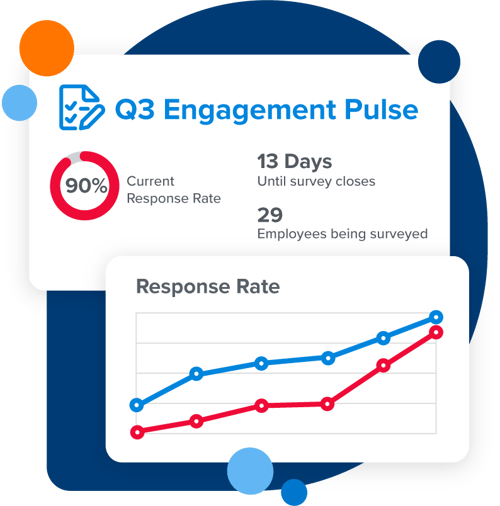
PULSE SURVEY TOOLS
Easily launch and analyze pulse surveys for timely topical feedback.
Our pulse surveys are easy to launch, complete, and analyze so you can get real-time feedback on pressing workplace topics.
Launch a pulse survey in minutes
When change comes, you need quick and efficient ways to collect employee feedback. In our pulse survey software, you can deploy a survey within minutes and be on your way to critical insights.
- Simple survey creation: step-by-step tutorials help you move through the process with confidence
- Smart segmentation: suggested participant lists make sending invites a breeze
- Question library: list of saved questions from past surveys for reuse
- Attribution options: flexible settings for attributed, confidential, or anonymous feedback
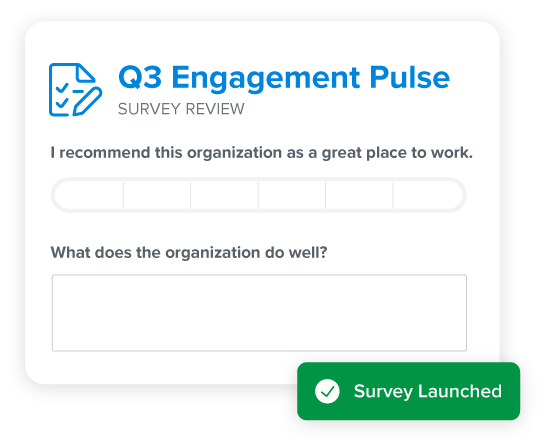
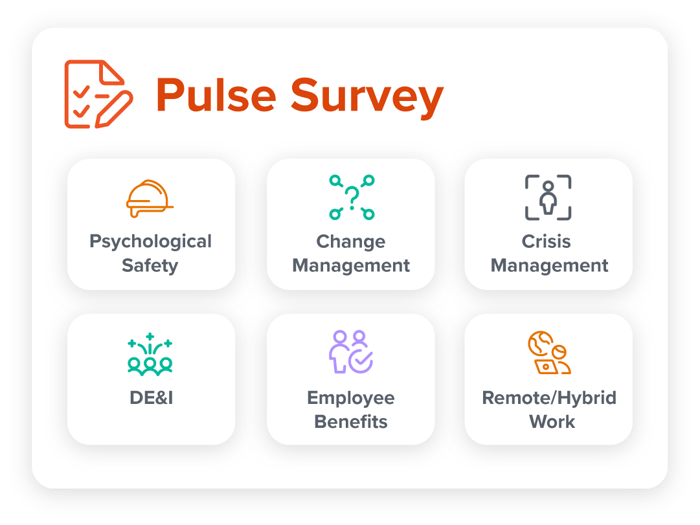
Use trusted templates on key workplace topics
To get the best insights, you need to ask the right questions. Our workplace experts are constantly adding new questions to address the most critical topics. Use Quantum Workplace’s best practice templates or make your own.
-
Diversity & Inclusion
-
Change Management
-
Employee Benefits
-
Crisis Management
-
Psychological Safety
-
Remote/Hybrid Work
Deliver a survey experience employees love
If your survey experience is clunky or cumbersome, employees are less likely to take part—and you’ll miss out on essential feedback. Our survey interface is clean and easy to use, driving high participation and encouraging thoughtful feedback.
- Personalized homepage: survey reminders at the top of every homepage
- Mobile-friendly: easy-to-complete on any device, anywhere
- Real-time notifications: in-tool and in-app reminders to encourage follow-through
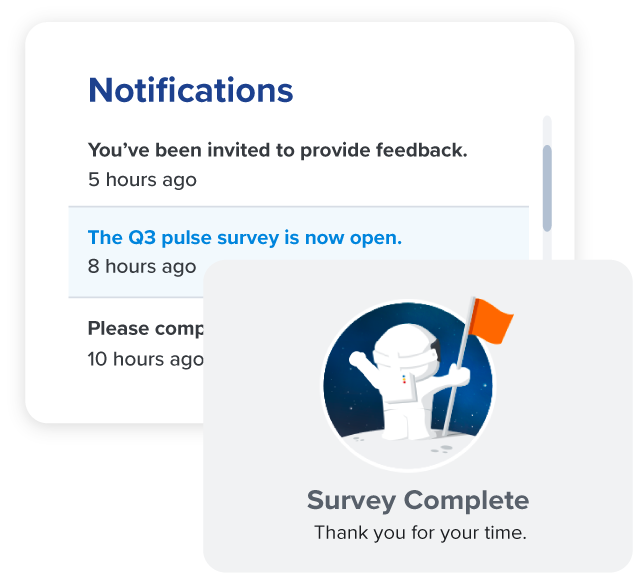
Get real-time results for immediate insights
We know you’re antsy to see your results. Our real-time survey analytics allow you to watch your responses roll in so you can move quickly from insights to action.
- Real-time analytics: responses analyzed as surveys are completed
- Trending results: questions can be compared across segments or over time
- Custom demographic filters: unlimited ways to slice 'n dice your data
- Simplified reporting features: elevated key takeaways for team leaders
- Interactive data visualizations: easily understand complex data and trends
Pulse any employee – wherever they are
Don’t choose tech that makes capturing feedback from a dispersed or deskless workforce difficult. You need solutions that can reach, activate, and empower your employees to participate wherever they are.
- Accessible options: desktop, kiosk, and SMS texting functionality
- Automated invites & reminders: technology handles the administrative work, so you don’t have to
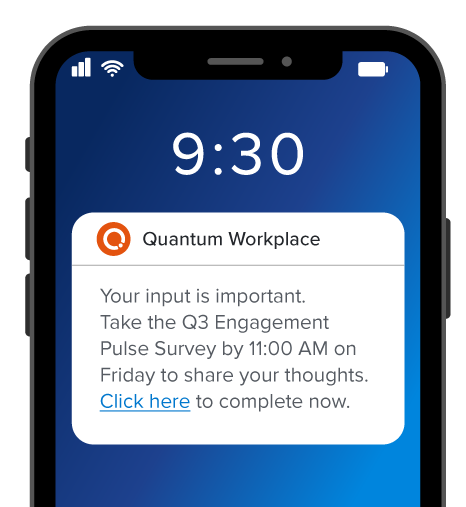
Find out why customers love Quantum Workplace
Pulse Survey Software FAQs
What is a pulse survey?
A pulse survey is an easy-to-implement survey designed to strategically collect employee opinions about important workplace topics in a time-efficient manner. It’s a way to follow up on key discoveries from an annual engagement survey or receive quick feedback on strategic workplace initiatives.
What are the benefits of pulse surveys?
The main benefit of pulse surveys is that they give you the ability to collect data more frequently than annual engagement surveys. But beyond that, pulse surveys have many benefits that can improve employee, team, and business success. Pulse surveys can help you:
- Increase communication and transparency
- Build trust
- Improve culture
- Collect real-time feedback
- Inform and enable smarter decisions
How do I develop a pulse survey strategy?
Creating a pulse survey strategy that fits your organization’s needs involves a few steps before you launch. Here are the five steps we recommend taking:
- Define Your Purpose: Have a clear picture of what you want to accomplish, so that you choose the right topics, questions, audience, and timeline.
- Set objectives: Pulse surveys are quick and easy – but if you launch one without a clear purpose, you’ll get results that don’t move your organization forward.
- Choose the right audience: Depending on the topic, you may want to survey your entire company, or specific segments of your workforce.
- Establish a frequency: The golden rule of conducting a pulse survey is to only gather feedback as often as you are able to act on it.
- Create a follow-up plan: Creating a plan and taking action after a pulse survey will help your employees and organization succeed – isn't that what collecting feedback is all about?
What are the best pulse survey questions?
Pulse survey questions are intended to collect quick and actionable responses. They should be timely and address a specific need. They can be used to follow up on team, department, and company-wide issues to continue making improvements.
Asking a variety of questions is great for understanding what’s working, what isn’t, and how to adjust to make the most of employees’ time. Here are 45 high-impact pulse survey questions you should be asking employees.
How do I choose the right pulse survey software?
We know that pulse surveys are a simple way to start learning more about your employees – but using the right pulse survey software can make sending pulse surveys a part of your bigger employee engagement strategy. Here are 6 elements to consider when choosing pulse survey software:
- Quick survey builds
- Survey customization
- Real-time access to results
- Manager-friendly
- Responsive tech support
- Helpful ideas in-tool
What makes Quantum Workplace’s pulse survey software different?
Whether you’re implementing a long-term strategy or launching a lightweight pulse survey – you need a partner you can rely on. For the last 20+ years, our customers have trusted us to deliver reliable expertise, technology, service and results.
We help you uncover meaning.
We're more than a survey tool. Our research-backed pulse survey templates, personalized analysis and insights, unparalleled benchmarks, and smart AI help you understand the meaning behind your employee pulse data.
We make action easy for everyone.
The real power of your employee pulse surveys is not in the surveys themselves, but in the action you take as a result. We make action easy for everyone — so leaders, HR, managers, and employees can all play their part in driving employee engagement.
We’re a partner you can rely on.
You’re on a journey – and we’re with you every step of the way. You can rely on our dedicated team to provide strategic guidance, ongoing coaching, timely tech support, and safe and secure practices your programs need to be successful.
EMPLOYEE ENGAGEMENT SUITE
Every tool you need to quickly move from engagement insight to action.
Pulse Surveys
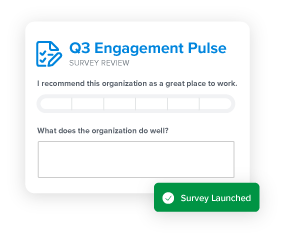
Get a pulse on what employees are feeling at any given time. Collect employee feedback efficiently on any topic.
Lifecycle Surveys
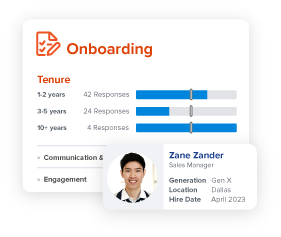
Assess and improve employees’ experience at every phase of their journey. Uncover insights at critical moments and milestones.
Analytics
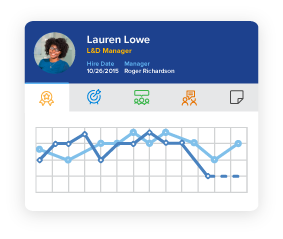
Understand the state of engagement and empower action with on-demand insights. Make sense of complex people data at-a-glance.
Benchmarks
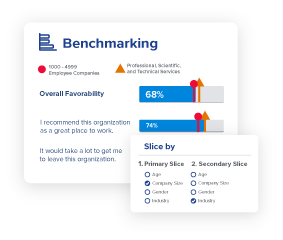
Get context that builds confidence with best-in-class comparisons. Compare your engagement results to similar organizations.
Action Planning
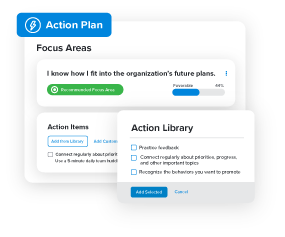
Create visibility and accountability for post-survey action. Reduce time-to-action, and increase impact. Enable managers to own and follow through on action items.
1-on-1s
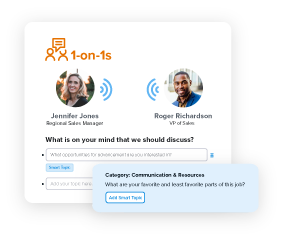
Strengthen manager and employee relationships through meaningful, ongoing conversations. Facilitate lightweight manager-employee 1-on-1s.
Want to see our employee engagement software in action?
Schedule a demo with one of our employee engagement experts today!



